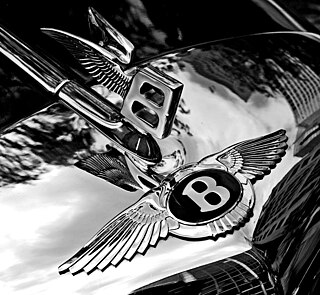
Bentley Motors Limited is a British designer, manufacturer and marketer of luxury cars and SUVs. Headquartered in Crewe, England, the company was founded as Bentley Motors Limited by W. O. Bentley (1888–1971) in 1919 in Cricklewood, North London, and became widely known for winning the 24 Hours of Le Mans in 1924, 1927, 1928, 1929 and 1930. Bentley has been a subsidiary of the Volkswagen Group since 1998 and consolidated under VW's premium brand arm Audi since 2022.

Walter Owen Bentley, was an English engineer who founded Bentley Motors Limited in London. He was a motorcycle and car racer as a young man. After making a name for himself as a designer of aircraft and automobile engines, Bentley established his own firm in 1919. He built the firm into one of the world's premier luxury and performance auto manufacturers, and led the marque to multiple victories at the 24 Hours of Le Mans. After selling his namesake company to Rolls-Royce Limited in 1931, he was employed as a designer for Lagonda, Aston Martin, and Armstrong Siddeley.

In automotive engineering a multi-valve or multivalve engine is one where each cylinder has more than two valves. A multi-valve engine has better breathing and may be able to operate at higher revolutions per minute (RPM) than a two-valve engine, delivering more power.

Chitty Bang Bang was the informal name of a number of celebrated British racing cars, built and raced by Count Louis Zborowski and his engineer Clive Gallop in the 1920s, which inspired the book, film and stage musical Chitty-Chitty-Bang-Bang.

Sir Henry Ralph Stanley Birkin, 3rd Baronet, known as Tim Birkin, was a British racing driver, one of the "Bentley Boys" of the 1920s.

The Bentley 3 Litre was a car chassis manufactured by Bentley. The company's first, it was developed from 1919 and made available to customers' coachbuilders from 1921 to 1929. The Bentley was very much larger than the 1368 cc Bugattis that dominated racing at the time, but double the size of engine and strength compensated for the extra weight. The 4000 lb (1800 kg) car won the 24 Hours of Le Mans in 1924, with drivers John Duff and Frank Clement, and again in 1927, this time in Super Sports form, with drivers S. C. H. "Sammy" Davis and Dudley Benjafield. Its weight, size, and speed prompted Ettore Bugatti to call it "the fastest lorry in the world", which was regarded as a compliment. Built in 3 main variants, Blue label, Red Label Speed models all carrying a 5-year warranty, and the coveted and rare Green Label 100 mph cars, which only carried a 12-month warranty reflecting the high state of tune.

The Bentley 4½ Litre is a British car based on a rolling chassis built by Bentley Motors. Walter Owen Bentley replaced the Bentley 3 Litre with a more powerful car by increasing its engine displacement to 4.4 litres. A racing variant was known as the Blower Bentley.
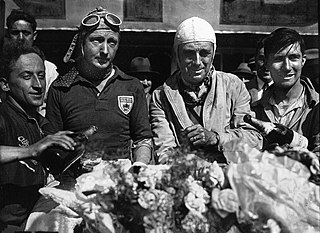
The 1931 24 Hours of Le Mans was the 9th Grand Prix of Endurance that took place at the Circuit de la Sarthe on 13 and 14 June 1931.
The 1930 24 Hours of Le Mans was the 8th Grand Prix of Endurance that took place at the Circuit de la Sarthe on 21 and 22 June 1930. It saw the first appearance of a German car and the first entry from female drivers.

The 1929 24 Hours of Le Mans was the 7th Grand Prix of Endurance that took place at the Circuit de la Sarthe on 15 and 16 June 1929.
The 1928 24 Hours of Le Mans was the 6th Grand Prix of Endurance that took place at the Circuit de la Sarthe on 16 and 17 June 1928.
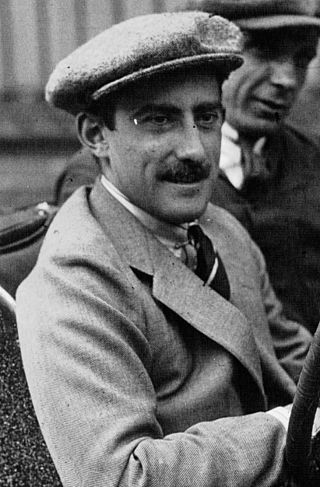
Louis Vorow Zborowski was an English racing driver and automobile engineer, best known for creating a series of aero-engined racing cars known as the "Chitty-Bang-Bangs", which provided the inspiration for Ian Fleming's children's story, Chitty Chitty Bang Bang and culminated in the "Higham Special" which, much modified in the hands of John Godfrey Parry Thomas, broke the World Land Speed Record 18 months after the death of its creator.

In an internal combustion engine, a supercharger compresses the intake gas, forcing more air into the engine in order to produce more power for a given displacement.

Jean Chassagne was a pioneer submariner, aviator and French racecar driver active 1906-1930. Chassagne finished third in the 1913 French Grand Prix; won the 1922 Tourist Trophy and finished second in the 1925 Le Mans Grand Prix d'Endurance - all in Sunbeam motorcars. He was second in the 1921 Italian Grand Prix with a Ballot, and set speed records and won races at Brooklands and hill climbs internationally.
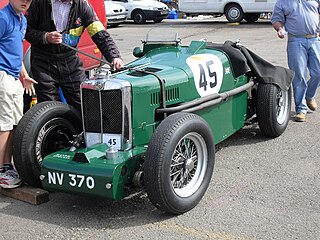
The MG Q-type is a racing car that was produced by MG in 1934. The chassis was based on the one used on the MG K3 but was narrower and used N-type axles. The engine used the cylinder block from the P-type but with a special crankshaft to bring the capacity down to 746 cc by reducing the stroke from 83 mm (3.3 in) to 71 mm (2.8 in). A high-pressure Zoller supercharger was fitted giving a boost to 2.5 atmospheres (1.8 kg/cc) and allowing the engine to produce 113 bhp (84 kW) at 7200 rpm. A sprint version was also made with output increased to 146 bhp (109 kW) which at nearly 200 bhp (150 kW) per litre was the highest specific output of any engine in the world at the time

The 1924 Grand Prix season saw Grand Prix motor racing spread further across Europe and North America. In Italy a number of new open-road events were held. In France two new circuits were opened – at Montlhéry near Paris and Miramas near Marseille.
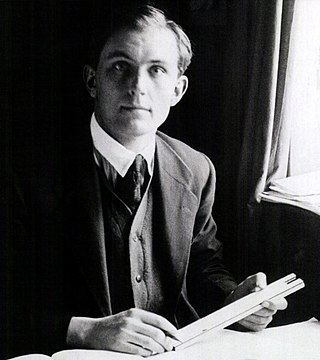
Amherst Villiers (1900–1991) was an English automotive, aeronautical and astronautic engineer and portrait painter. He designed a land speed record-breaking car for Malcolm Campbell, and developed the supercharged "Blower Bentley", driven by Henry Birkin and by James Bond.

Bentley Blower No.1 is a racing car developed from the Bentley 4½ Litre by Sir Henry "Tim" Birkin to win the Le Mans twenty-four-hour race. The car was developed into its current form for racing at Brooklands.
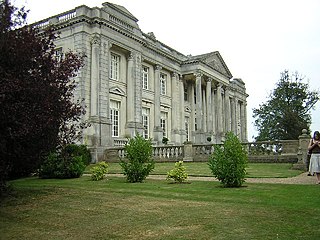
Higham Park is a Grade II* listed neoclassical style house and gardens, located at Bridge, Kent, 3 miles (4.8 km) south of Canterbury.
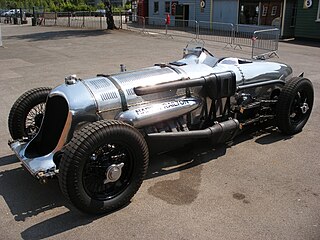
An aero-engined car is an automobile powered by an engine designed for aircraft use. Most such cars have been built for racing, and many have attempted to set world land speed records. While the practice of fitting cars with aircraft engines predates World War I by a few years, it was most popular in the interwar period between the world wars when military-surplus aircraft engines were readily available and used to power numerous high-performance racing cars. Initially powered by piston aircraft engines, a number of post-World War II aero-engined cars have been powered by aviation turbine and jet engines instead. Piston-engined, turbine-engined, and jet-engined cars have all set world land speed records. There have also been some non-racing automotive applications for aircraft engines, including production vehicles such as the Tucker 48 and prototypes such as the Chrysler Turbine Car, Fiat Turbina, and General Motors Firebirds. In the late 20th century and into the 21st century, there has also been a revival of interest in piston-powered aero-engined racing cars.



















